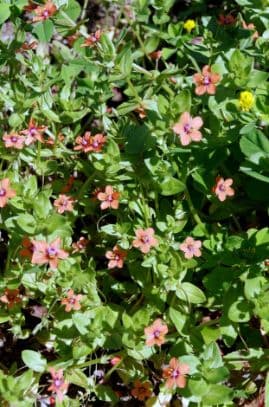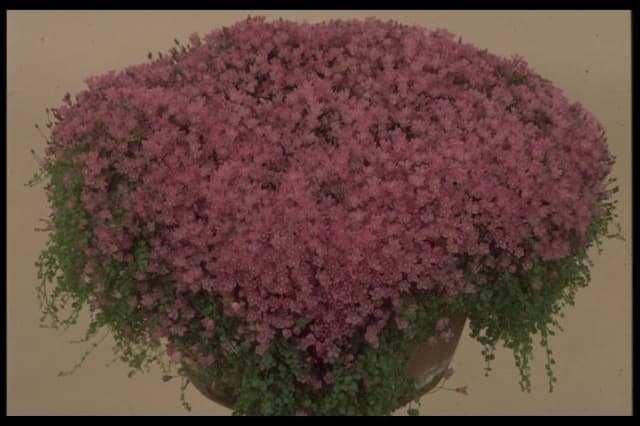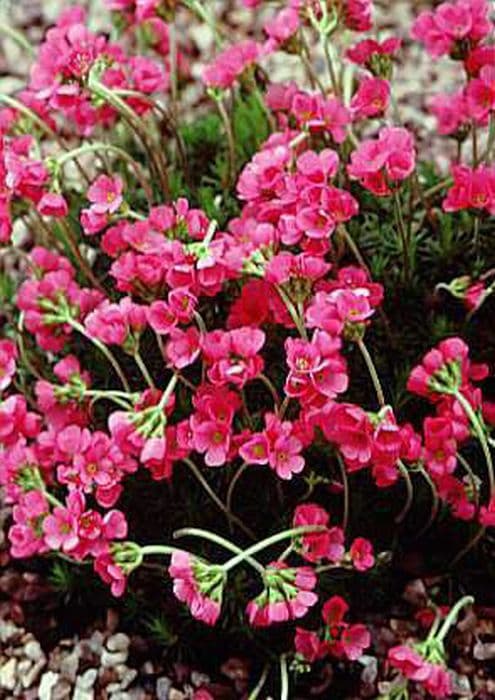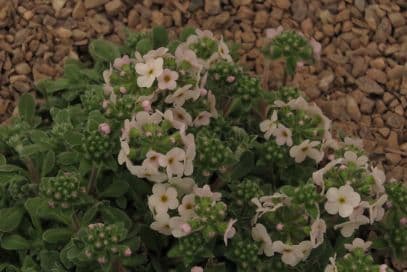Cushion Dionysia Dionysia tapetodes 'Peter Edwards'

ABOUT
Dionysia tapetodes 'Peter Edwards', commonly known as Cushion Plant, is a beautiful alpine species that forms a dense cushion or mat-like appearance. The foliage comprises tiny, dark green leaves that are closely packed together, creating a lush, mossy texture. Each individual leaf is small and may have a slightly round to oval shape with smooth edges, contributing to an overall velvety look of the foliage. The Cushion Plant blooms profusely in the right conditions, producing numerous small, brightly colored flowers. These flowers can be an eye-catching yellow hue, vivid and intense, which contrasts strikingly against the dark green of the leaves. The blooms typically appear at the ends of short stems that arise from the cushion of foliage, creating a stunning display. Due to its low-growing, mound-forming habit, the plant spreads across the ground rather than growing upwards, giving it a compact and neat appearance that is often praised in rock gardens and alpine displays. The texture of the plant is fine and delicate, making it a desirable addition for collectors and gardeners who appreciate intricate and detailed plant forms.
About this plant
 Names
NamesFamily
Primulaceae.
Synonyms
There are no common names, this plant is typically referred to by its botanical name.
Common names
Dionysia tapetodes 'Peter Edwards'.
 Toxicity
ToxicityTo humans
Dionysia 'Peter Edwards' does not have a well-documented profile of toxicity to humans. Generally, Dionysia species are not known for being poisonous to humans. If the plant had any toxic properties, symptoms might include gastrointestinal upset, such as nausea, vomiting, or diarrhea. However, without specific information on this cultivar's toxicity, it is advisable to avoid ingesting any part of the plant and to keep it out of reach of children who may accidentally consume it.
To pets
Dionysia 'Peter Edwards' is not commonly listed as a toxic plant for pets. As with humans, Dionysia species are not well-known for their toxicity to animals. If it were toxic, ingestion could potentially lead to symptoms such as vomiting, diarrhea, or drooling in pets like cats and dogs. Nevertheless, it is always prudent to prevent pets from ingesting plants not intended for consumption, as individual animals might react differently, and there may be a lack of detailed information on the toxicity of specific cultivars.
 Characteristics
CharacteristicsLife cycle
Perennials
Foliage type
Evergreen
Color of leaves
Green
Flower color
Yellow
Height
0.5 feet (15 cm)
Spread
1 feet (30 cm)
Plant type
Herb
Hardiness zones
Varies
Native area
Iran
Benefits
 General Benefits
General Benefits- Ornamental appeal: Adds aesthetic beauty to gardens with its cushion-like growth form and appealing flowers.
- Rock garden suitability: Ideal for rock gardens due to its low-growing, mat-forming nature.
- Pollinator attraction: Flowers can attract bees and other pollinators, supporting local biodiversity.
- Drought tolerance: Once established, it can tolerate periods of drought, making it suitable for xeriscaping.
- Low maintenance: Requires minimal care beyond the initial planting and establishing period.
- Cold hardiness: Capable of withstanding cold temperatures, making it suitable for alpine or cold-region gardens.
 Medical Properties
Medical PropertiesThis plant is not used for medical purposes.
 Air-purifying Qualities
Air-purifying QualitiesThis plant is not specifically known for air purifying qualities.
 Other Uses
Other Uses- Miniature garden landscaping: Dionysia tapetodes can be used in creating intricate miniature gardens due to its small size and dense, cushion-like growth habit.
- Photography subject: The plant's intricate patterns and vibrant flowers make it a beautiful subject for macro photography and plant portraiture.
- Study of Alpine plant survival: Scientists can study Dionysia tapetodes to understand how alpine plants adapt to harsh, high altitude conditions.
- Education on Iran's flora: Being native to Iran, it can be used in educational programs to teach about the unique plants found in that region.
- Collecting: Dionysia tapetodes is a collectible plant for enthusiasts who focus on rare and alpine species.
- Bonsai alternative: Its slow growth and compact form make it a unique alternative to traditional bonsai plants.
- Aromatic display: While not overpowering, the plant has a subtle fragrance that can be appreciated when grown in clusters or when brought indoors.
- Culinary decoration: The non-toxic flowers can be used as edible decorations for gourmet dishes, although this is not a common practice.
- Gift plant: Due to its aesthetic appeal and rarity, it can be given as a gift to plant lovers and collectors.
- Artistic inspiration: The form and colors of Dionysia tapetodes can inspire artists and designers in creating patterns or jewelry.
Interesting Facts
 Feng Shui
Feng ShuiThe Dionysia is not used in Feng Shui practice.
 Zodiac Sign Compitability
Zodiac Sign CompitabilityThe Dionysia is not used in astrology practice.
 Plant Symbolism
Plant Symbolism- Endurance: Dionysias, also known as cushion plants, often thrive in harsh alpine conditions, symbolizing the ability to endure difficult circumstances and maintain resilience.
- Rarity and Uniqueness: Dionysia tapetodes is a rare species, representing uniqueness and the value of rare beauty in our lives.
- Appreciation of Nature: With their preference for specific high-altitude environments, they symbolize an appreciation for the natural world and the importance of caring for our environment.
- Patience: As slow-growing plants, they represent patience and the rewards of taking time to nurture growth and development.
- Adaptation: Their ability to survive in rocky crevices symbolizes adaptability and finding a way to flourish in challenging conditions.
 Water
WaterCushion bush should be watered moderately, ensuring the soil remains slightly moist but never soggy. During active growth in the spring and summer, watering once a week with approximately 16 ounces of water is typically adequate. During the winter months, reduce watering to once every two to three weeks, providing only about 8 ounces of water to prevent the soil from drying out completely. It's essential to provide good drainage to avoid root rot, and watering should be adjusted based on humidity, temperature, and light conditions.
 Light
LightCushion bush thrives best in bright, indirect light and can tolerate some direct sunlight, especially in the cooler hours of the morning. A south or west-facing window with filtered light is an ideal spot for this plant. Avoid placing it in full afternoon sun, which can scorch its leaves, or in deep shade, which can lead to weak, leggy growth.
 Temperature
TemperatureCushion bush prefers cool to average room temperatures, with ideal conditions ranging between 50°F and 68°F. It can tolerate a minimum temperature of about 40°F, but frost should be avoided. The plant can survive maximum temperatures up to about 75°F, but it should be protected from sudden temperature fluctuations and drafts.
 Pruning
PruningCushion bush benefits from occasional pruning to shape the plant and promote bushier growth. It’s best to prune after the blooming period, typically in late spring or early summer. Remove any dead or damaged stems and lightly trim back overgrown parts to maintain the cushion-like appearance. Pruning every year or every other year is often sufficient.
 Cleaning
CleaningAs needed
 Soil
SoilFor Dionysia tapetodes 'Peter Edwards', commonly known as Peter's cushion, a soil mix should be composed of equal parts of loam, grit, and peat-free compost. The pH should be slightly acidic to neutral, ideally between 6.0 and 7.0 for optimal growth.
 Repotting
RepottingPeter's cushion (Dionysia tapetodes 'Peter Edwards') should be repotted every one to two years to refresh the soil and provide room for growth. It is best to repot in the spring, just before the new growth begins.
 Humidity & Misting
Humidity & MistingPeter's cushion prefers a moderate to high humidity level, ideally between 50% and 70%. Avoid placing the plant in dry conditions which may impede its growth and flowering.
 Suitable locations
Suitable locationsIndoor
Provide bright light, and cool temps for Peter's cushion.
Outdoor
Use well-draining soil, protect from hot sun and winter wet.
Hardiness zone
5-7 USDA
 Life cycle
Life cycleThe life of Dionysia tapetodes 'Peter Edwards', commonly known as Cushion Primrose, begins with seed germination, which typically occurs in a cold and moist environment, mimicking the alpine conditions of its native habitat. Once germinated, the seedlings develop into a basal rosette of leaves as they progress through the juvenile stage, slowly forming a dense, cushion-like mound. As the plant matures, it exhibits vigorous vegetative growth and eventually produces clusters of small, attractive yellow flowers in the spring, primarily in its second or third year. Following pollination, which is often facilitated by insects, the flowers develop into small capsules containing numerous seeds. After seed dispersal, the parent plant continues to grow and bloom annually for several years, being a perennial. The Cushion Primrose eventually reaches senescence and dies, completing its life cycle, which may span several years depending on environmental conditions and care provided.
 Propogation
PropogationPropogation time
Spring-Summer
Propogation: Dionysia tapetodes 'Peter Edwards', commonly known as Peter Edwards Alpine Dionysia, is most commonly propagated through seed sowing. Ideally, seeds should be sown in the fall or winter to allow for a cold stratification period, which enhances germination. Sow the seeds on the surface of a well-draining soil mix and cover lightly with a thin layer of soil or grit. The container should be kept in a cool, bright place, and the soil should be maintained moist but not waterlogged. Germination can be slow and erratic, but once the seedlings appear, they should be carefully transplanted into their individual pots when large enough to handle. This method is preferred by collectors and enthusiasts for producing true-to-type plants.









